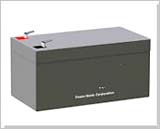 Discovered in 1859, by French physicist Gaston Plante, Lead / Acid batteries are the oldest type of rechargeable batteries. Economical in cost, these batteries have a high power to weight ratio that makes them an attractive option for application in cars, as they can provide the high current required by the automobile starter motors. These batteries have a low energy to weight ratio, which makes them suitable for uses in vehicles, such as forklifts, wherein the low ration can be used as a counterweight in the vehicle. Big arrays of lead-acid cells have found uses as standby sources of power for generating stations, telecommunications facilities, and computer data centers. These motors are also used nowadays to provide power to electric motors in diesel-electric (conventional submarines).
Discovered in 1859, by French physicist Gaston Plante, Lead / Acid batteries are the oldest type of rechargeable batteries. Economical in cost, these batteries have a high power to weight ratio that makes them an attractive option for application in cars, as they can provide the high current required by the automobile starter motors. These batteries have a low energy to weight ratio, which makes them suitable for uses in vehicles, such as forklifts, wherein the low ration can be used as a counterweight in the vehicle. Big arrays of lead-acid cells have found uses as standby sources of power for generating stations, telecommunications facilities, and computer data centers. These motors are also used nowadays to provide power to electric motors in diesel-electric (conventional submarines).
The growth in the number of automotive vehicles on roads as well as in several other applications has increased the demand for lead / acid batteries. With so many batteries in use, their disposal and recycling is of significant importance. The used battery is 99% recyclable if it is treated in a proper facility and under environment friendly conditions. Lead is the most recycled metal with more than 50% of world demand met by recycled lead itself. The used and spent battery should be seen as a source of lead, as in 1999-2000 around 110,000 MT of lead would be available from automobile sector alone.
In the absence of adequate smelting facilities and legislations regarding the recycling of lead acid batteries, the spent battery find its way to backyard smelting units. Here, the lead is recovered from batteries in a very crude manner that degrades the surrounding areas and the health of workers.
UsesLead-acid batteries have found uses in a variety of applications, however all these batteries provide either starting or deep cycle power. The major difference, only being is how much power is delivered and how long it needs to be delivered.
Starting BatteriesLead / Acid batteries that are engineered for starting automotive engines are not designed for deep discharge. These batteries have a large number of thin plates, which are designed for optimum surface area, and hence optimum current output, but that can easily be damaged by deep discharge. Repeated deep discharges result in loss of capacity and ultimately in premature failure, as the electrodes disintegrate due to the mechanical stress, which arise from recycling.
These batteries should be kept open-circuit, however should be charged regularly to prevent sulfation. Deep Cycle Batteries
Deep cycle batteries are much less susceptible to degradation due to cycling and have found uses in applications, where the batteries are consistently discharged, such as electric vehicles, photo voltaic systems and uninterrupted power supplies. Deep cycle batteries have thicker plates, which can can render less peak current, but can withstand frequent discharging.
